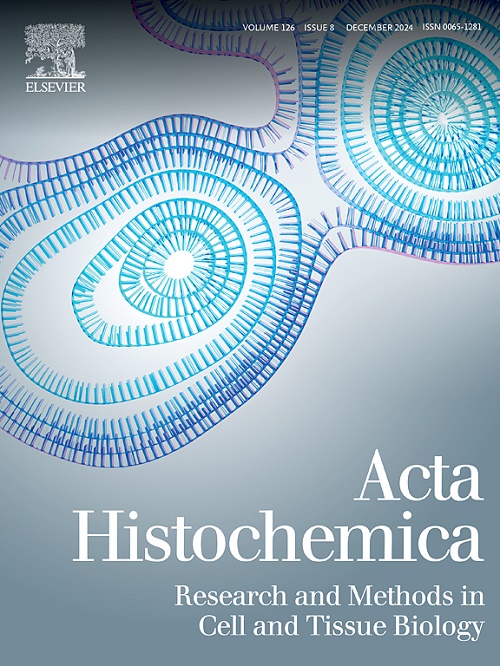Calcipotriol inhibits the proliferation of psoriasis HaCaT cells by activating the ferroptosis pathway
IF 2.4
4区 生物学
Q4 CELL BIOLOGY
引用次数: 0
Abstract
Calcipotriol is a well-established treatment for psoriasis and other dermatological conditions. This study aimed to investigate whether calcipotriol exerts its therapeutic effects through ferroptosis and to elucidate its underlying molecular mechanisms using bioinformatics and cellular experiments. Differentially expressed genes (DEGs) and their functional enrichment were analyzed in psoriatic skin lesions using bioinformatics. A lipopolysaccharide (LPS)-induced HaCaT cell model was established to simulate psoriatic inflammation. The effects of calcipotriol at various concentrations and time points on HaCaT cell proliferation, apoptosis, and expression of key markers were assessed. Additionally, ferrostatin-1 (a ferroptosis inhibitor) and RSL3 (a ferroptosis inducer) were used to evaluate ferroptosis-related changes, including cell proliferation, apoptosis, reactive oxygen species (ROS) levels, glutathione (GSH) content (via ELISA), and protein expression of GPX4 and Ki-67 (via Western blot). Bioinformatics analysis revealed significant differential expression of ferroptosis-related genes, such as GPX4 and SLC7A11, in psoriatic lesions. Calcipotriol treatment inhibited HaCaT cell proliferation in a dose- and time-dependent manner, elevated ROS levels, and reduced GSH, GPX4, and Ki-67 expression. These effects were reversed by ferrostatin-1, which restored antioxidant defenses and cell viability. Conversely, RSL3 increased ROS levels and partially negated the protective effects of ferrostatin-1. These findings suggest that calcipotriol regulates ferroptosis-related gene expression and inhibits keratinocyte proliferation through induction of oxidative stress and ferroptosis, offering new insights into its mechanism of action in psoriasis treatment.
钙化三醇通过激活铁下垂途径抑制银屑病HaCaT细胞的增殖
钙化三醇是治疗牛皮癣和其他皮肤病的有效方法。本研究旨在通过生物信息学和细胞实验研究钙化三醇是否通过铁下垂发挥其治疗作用,并阐明其潜在的分子机制。应用生物信息学方法对银屑病皮损中的差异表达基因(DEGs)及其功能富集进行了分析。建立脂多糖(LPS)诱导HaCaT细胞模型,模拟银屑病炎症。观察不同浓度、不同时间点钙三醇对HaCaT细胞增殖、凋亡及关键标志物表达的影响。此外,利用铁抑素-1(一种铁下垂抑制剂)和RSL3(一种铁下垂诱诱剂)评估铁下垂相关的变化,包括细胞增殖、凋亡、活性氧(ROS)水平、谷胱甘肽(GSH)含量(通过ELISA)以及GPX4和Ki-67的蛋白表达(通过Western blot)。生物信息学分析显示,银屑病皮损中与铁中毒相关的基因GPX4和SLC7A11的表达存在显著差异。钙化三醇以剂量和时间依赖性的方式抑制HaCaT细胞增殖,升高ROS水平,降低GSH、GPX4和Ki-67的表达。这些作用被铁他汀-1逆转,恢复抗氧化防御和细胞活力。相反,RSL3增加ROS水平,部分抵消了铁stat -1的保护作用。这些发现提示钙化三醇通过诱导氧化应激和铁下垂调节铁中毒相关基因表达,抑制角化细胞增殖,为其治疗银屑病的作用机制提供了新的见解。
本文章由计算机程序翻译,如有差异,请以英文原文为准。
求助全文
约1分钟内获得全文
求助全文
来源期刊

Acta histochemica
生物-细胞生物学
CiteScore
4.60
自引率
4.00%
发文量
107
审稿时长
23 days
期刊介绍:
Acta histochemica, a journal of structural biochemistry of cells and tissues, publishes original research articles, short communications, reviews, letters to the editor, meeting reports and abstracts of meetings. The aim of the journal is to provide a forum for the cytochemical and histochemical research community in the life sciences, including cell biology, biotechnology, neurobiology, immunobiology, pathology, pharmacology, botany, zoology and environmental and toxicological research. The journal focuses on new developments in cytochemistry and histochemistry and their applications. Manuscripts reporting on studies of living cells and tissues are particularly welcome. Understanding the complexity of cells and tissues, i.e. their biocomplexity and biodiversity, is a major goal of the journal and reports on this topic are especially encouraged. Original research articles, short communications and reviews that report on new developments in cytochemistry and histochemistry are welcomed, especially when molecular biology is combined with the use of advanced microscopical techniques including image analysis and cytometry. Letters to the editor should comment or interpret previously published articles in the journal to trigger scientific discussions. Meeting reports are considered to be very important publications in the journal because they are excellent opportunities to present state-of-the-art overviews of fields in research where the developments are fast and hard to follow. Authors of meeting reports should consult the editors before writing a report. The editorial policy of the editors and the editorial board is rapid publication. Once a manuscript is received by one of the editors, an editorial decision about acceptance, revision or rejection will be taken within a month. It is the aim of the publishers to have a manuscript published within three months after the manuscript has been accepted
 求助内容:
求助内容: 应助结果提醒方式:
应助结果提醒方式:


